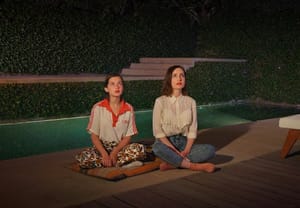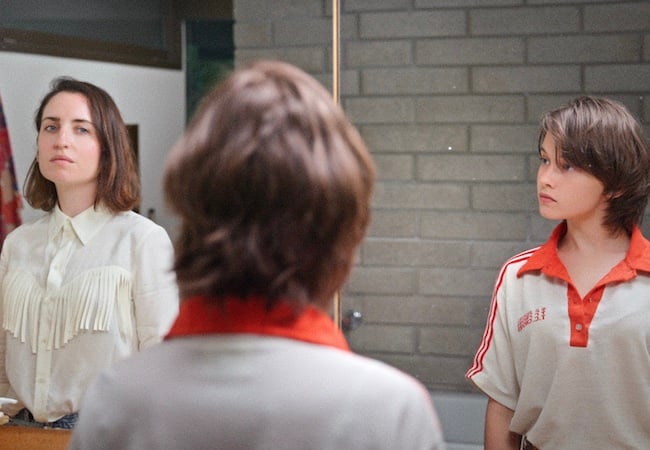
Zoe Lister-Jones and Daryl Wein plumbed and heightened all of the emotions of the last year for How It Ends, in which Lister-Jones plays a woman named Liza who spends the last day of humanity wandering some of L.A.’s lovelier neighborhoods with her inner child (Cailee Spaeny, who is best known for her tragic turn as Erin McMenamin in Mare of Easttown and also stars in Lister-Jones’ upcoming The Craft: Legacy). As an asteroid nears, Liza and Inner Child encounter a series of curious personalities played by a murderers’ row of comic actors, from Whitney Cummings to Fred Armisen to Olivia Wilde to… let’s stop listing names, because one of the joys of the movie is seeing who will appear next. In the piece below, Lister-Jones talks about shooting a movie in the spring and summer of 2020 that addressed what everyone was feeling, but wasn’t about the pandemic. She and Wein wrote, produced and directed How It Ends, which is out now.
Daryl and I tend to process our feelings through our work. And we were doing a lot of inner child work in our respective virtual therapy sessions, because a lot was coming up. As we were being forced to face our most vulnerable selves, and trying to figure out how to speak to those inner children who are needing a lot of assurance, we were also feeling a lot of despair and hopelessness and concern over the future of filmmaking. We just didn’t know when we would be able to get back into the creative sort of spirit in that way.
Our inner children are always looking to be heard when it comes to their fears and their sense of safety, whatever that means for each person. It’s so much about what we weren’t able to express—or if what we did express as children wasn’t really received or responded to by those taking care of us. We sort of have to — no shade to our parents — but reparent those inner children ourselves, as adults. And what does that look like? And what does that look like in the context of this apocalyptic landscape?
We didn’t want to make a film that was centered in the pandemic, literally, but we were interested in exploring the emotional landscape that we were living in, in an adjacent manner. So the last day on earth felt pretty resonant. I think the Trump presidency felt like a slow burn to the end of humanity every day. I don’t think any of us can really even fathom unpacking the last four years. We’re just at the beginning of understanding what traumas our psyches have endured from that experience. Whether or not the world was ending, it felt like democracy might be ending, and that we might be entering something that none of us had ever faced in our lifetimes in this country.
That in combination with, obviously, a global pandemic, felt apocalyptic. I think the reason why we wanted to make a film that was sort of playing with the banality of the apocalypse was because every time you see the apocalypse portrayed in cinema, it’s violent mayhem. And I think what was interesting to us about the sort of apocalypse occurring in real life was that the world felt like it was ending, but we were watching Netflix in sweatpants.
Also Read: How It Ends Explores L.A.’s Overcomplicated Class on the Last Day on Earth
I chose Cailee Spaeny to play my character’s inner child after we met on The Craft: Legacy, which we had shot over the fall of 2019. For that story I wrote a sort of revamp of the original, and infused it with a lot of my own personal, adolescent narrative.
So in a sense, Cailee was already playing my teenage self. And I think filming that for both of us was really transformative and cemented a very deep friendship between us, in addition to a creative collaboration. We had very different upbringings, but I think that on a soul level we’re really similar people, in many ways.
And then when quarantine began, she was in LA, and so we were going on a lot of socially distanced walks. We became a part of a pod. And we were both dealing a lot with our inner children, having nothing to do with the work we had done on The Craft. And so it was very organic. I mean, I would work with her on anything—she’s such a brilliant actor. And having worked with her on The Craft, it was clear that she would be one of my players forever as a director, and this was a great opportunity for us to then also be able to act opposite one another, in addition to me being able to direct her. It was really a dreamy collaboration and one that happened quite naturally.
In the content that Daryl and I were looking to consume, we were looking for things that could make us laugh but could make us feel as well. That’s such a specific Venn diagram. We’re always really excited when we can make films that can navigate both humor and meaning or poignancy. As human beings, it was important for us to try to be playful, even though it felt so anathema to what we were going through.
All Newsletters Are Awful, Except Ours. Won’t You Take 10 Seconds to Sign Up?
When we reached out to our friends who co-starred in the film with me, almost all of them hadn’t been in front of the camera yet during quarantine. And there was some concern with some of our actors: “I don’t know that I can show up and be funny right now.” And these are some of the greatest comic actors of my generation. So it was an interesting challenge. For me to say, “I can still show up and do my job, I can have a sense of play in a very bleak and harrowing time”—for me at least, it really was a lifeline.
The beauty of the conceit was that you could show up wherever you were emotionally on that day. If you were in a deep state of depression and despair, then that’s what your character is.
We shot some people in their actual backyards, and then other people in friend’s backyards that we could enter through a side gate. It was all dependent on each actor’s comfort level.
Daryl and I started by making distinctly New York films. And then we moved to L.A. I think it’s a love letter and commentary on the beauty and also ridiculous nature of being an Angeleno. Everyone is trying to be the best version of themselves. Which felt resonant for us, because I think that quarantine, amongst many things, obviously put the importance of human connection into hyper focus. When you would talk to people there was a different attention to the way friendships were valued or communication was valued. There was more tenderness, I think, and so we were looking to play with that a little bit—and also make fun of it, because there’s a lot of misguided tenderness. Bradley Whitford’s character is really trying to connect, but is just too narcissistic to do so successfully.
I’m very grateful that it feels like there’s some light at the end of the tunnel, with the vaccines and witnessing the world open up a little bit more. I hope that it fades a little bit more into a memory rather than such an intense and destabilizing present. The film does serve as a time capsule, for me personally, in a way that’s very meaningful. And it doesn’t feel like the distant past. But I think it serves as a nice reminder of some of the lessons that we learned and are continuing to learn.

Liza (Zoe Lister-Jones) reflects on her Inner Child (Cailee Spaeny) in How It Ends.
The film asks: What do you do if you have one day? I think that was a heightened version of a larger tenet of the year: What is important to you? For so many of us, work and the hustle is at the forefront of our identities. And I think, for me at least, the last year and a half really forced me to face that. Who am I outside of the hustle? Who am I outside of just constantly grinding to get to that next milestone in my career?
And do I prioritize life in the same way?
Making the film was interesting in that way, because it was work, but it was also sort of experimental on a spiritual level—a sort of cathartic enterprise by design. It’s already stressful making independent films, but adding a pandemic to the mix was just an added set of challenges. But we were really light on our feet in terms of our crew, and Daryl and I were wearing so many hats, we were in a very intimate emotional space where we could explore things that we maybe wouldn’t on a more conventional set. And as Daryl mentioned at one point, other movies would pay gazillions of dollars to clear L.A. of cars. So we had this singular opportunity to capture a sort of apocalyptic landscape IRL.
How It Ends, by Zoe Lister-Jones and Daryl Wein, is now in theaters from United Artists.
>Main image: Zoe Lister-Jones and Cailee Spaeny in How It Ends.
